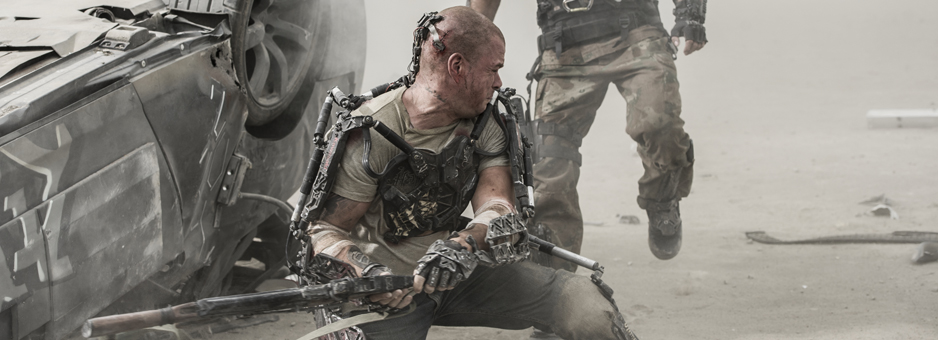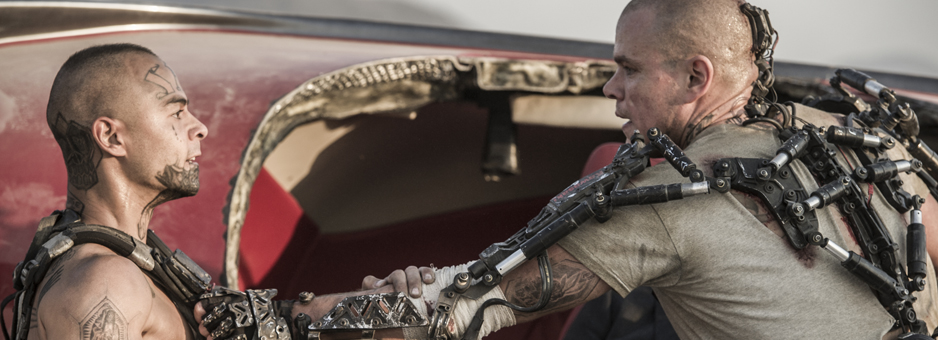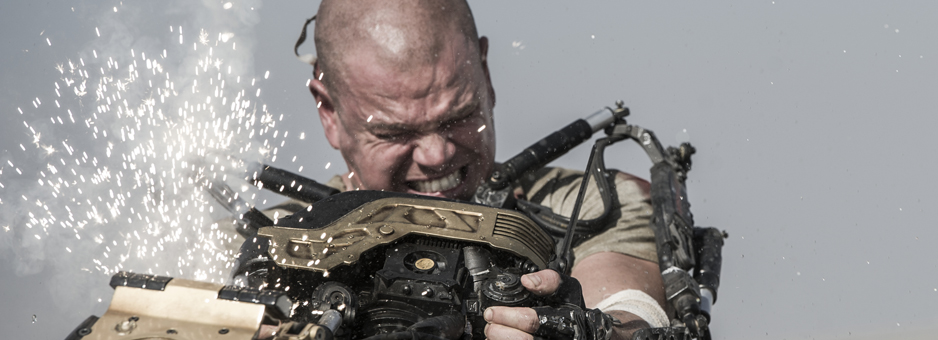Creating a 4K ACES Finish for Elysium
SKYLAB (formerly Digital Film Central) relied on a Baselight TWO to help create a fully ACES-compliant and flexible color pipeline, from VFX pre-grading to the final DI.
Written and directed by Neill Blomkamp, Elysium is a highly anticipated science-fiction movie starring Matt Damon and Jodie Foster. Set in the year 2154, two classes of people exist: the very wealthy, who live on a pristine man-made space station called Elysium, and the rest, who live on an overpopulated, ruined planet.
This effects-heavy movie came with many visual, creative and workflow challenges and Vancouver-based post facility Digital Film Central (Central) was on hand to oversee the process from start to finish. Central, which offers complete, end-to-end picture post-production services, prides itself on having a forward-thinking approach.
For Elysium, Central constructed a 3.3K color and conform workflow that tightly integrated DI with editorial and VFX. Working on Baselight, the end result provided Blomkamp with unmatched creative freedom and for Central's senior DI colorist, Andrea Chlebak, there were no barriers in terms of what they were able to achieve when creating the final look for the film.
Collaborating closely with Image Engine, the lead VFX house, Central was involved in the production from the early stages. "As a very heavy VFX movie, the production itself was really cognizant of color being handled properly from the get-go," commented Chlebak. "We had worked with Image Engine in the past and have a reputation for being really accurate with color and workflow, so we were a good fit.
"We started coordinating things with the post supervisor, Brad Goodman, on the color management and image optimization pipelines for the film, and began testing a few different camera set-ups to see what would work for some of the more unique VFX shots," Chlebak elaborated. "As part of that process, I naturally became involved in discussions with Neill about the look of the film and we connected on his vision for Elysium."
"The aesthetic for Elysium was incredibly important to me," explained Blomkamp. "A lot of Andrea's instincts were in line with mine and that just makes for a very seamless, smooth process."
Chlebak's brief for the look of the movie was to create something 'real' that wouldn't have a transformative effect on the film, or distract the audience from being immersed in the story. With this in mind, the team developed a workflow and process that would provide Chlebak and Blomkamp the ideal environment to take the subtle approach to the grade he sought after.
The guiding theme was the two distinct worlds. "We were most interested in the look we wanted to create for the two worlds – the first being Earth in the year 2154, and the second being the incredible looking space station just off of Earth, called Elysium," explained Chlebak. "A lot was already there from the photography and art direction, so I studied those styles and started to work with Neill on Baselight, creating a handful of different and interesting looks to help enhance each scene.
Before the VFX work began, the team wanted to know what the final look of the film was going to be, so Central identified a few 'hero shots' and pre-graded them in Baselight under Blomkamp's direction. These looks were then carried over to the VFX team and distributed to all departments, allowing them to preview their composites. At the same time, Central was pre-grading and optimizing every shot that editorial was pulling for visual effects, creating a transparent bridge between the VFX pipeline and the DI pipeline, with editorial connected to both.
"Basically, the VFX vendors were all receiving ungraded EXRs, graded EXRs and a CDL from Baselight of what the grade was, so if they needed to back out of the grade for any reason they could," recalled Chlebak. "At first we did all of the pre-grading for VFX plates with the VFX supervisor, grading at 50 or 100 shots at any one time. With him knowing what was coming in terms of effects and me knowing what the final look of that scene was going to be, we were able to work together to optimize the pre-grade for both VFX and DI simultaneously.
"It also meant that when Neill was at the VFX house reviewing the final shots, he could be confident that what he was seeing was the same as what we were seeing over at Central, when I was going through the DI," she added. "And VFX were never concerned that their work would be drastically altered in DI because they were able to preview their work in the context of Neill's preferred look."
The VFX pre-grade was critical in terms of creativity for the artists and for Blomkamp but Central also implemented another unique factor into the workflow by switching the entire VFX pipeline over to ACES, the Academy Color Encoding System.
"A big thing that happened with Elysium is that we worked with the VFX supervisor to switch everyone's workflows over to ACES," explained Chris Davies, the director of operations and color workflows at Central. "We had gone through ACES workflows in-house on DI's before, but we figured this project was a good opportunity to unify the worlds of DI and VFX. I knew this meant leaving behind the world of DPX and embracing OpenEXR. With full support for the OpenEXR spec in Baselight, ACES support with Truelight, and floating-point GPU grading built-in, the timing was perfect."
"We spent a lot of R&D time prior to starting VFX to tune every aspect of the ACES and OpenEXR workflows," said Davies. "We worked directly with the VFX teams, FilmLight, and the ACES developers, testing effects comps and grading strategies, and adding or refining software features on key systems. The results were worth the effort, as the CG married unbelievably well with the camera footage and achieved the goal of photo-realism that Neill had for the film."
Switching the DI and VFX to ACES OpenEXR meant that all the pre-grading could be done in the same format as the effects and finish, while maintaining the linear-light workflow that demanding CG requires. There were no look treatments baked into VFX plates, and anything that required a look treatment could be represented in the Truelight LUTs that were handed out to the VFX team.
"It was really powerful to be able to view the footage as if it was the finished DI, with full grades applied. However, as soon as we needed to hand over the plates to VFX we could just turn all that off and render EXRs. And the plates were seamless from shot to shot because they'd been pre-graded in context of the final look" added Davies. "The effects artists were able to work from plates that were photographically pure, while still having access to the final looks while working."
Having Baselight and Truelight built into the workflow made the process really adaptable and if anything changed, or the ACES team rolled out a new update, it was quick and easy to adapt the Baselight and the VFX workflow.
"We've had a Baselight since 2007 and have a lot of confidence in its abilities," comments Chlebak. "This goes a long way in terms of being able to become more flexible with workflow as well. I honestly don't know if we would have been able to achieve what we did for this movie if we were using another grading system – Baselight is so intuitive and flexible that it allows us to focus on innovation."
Most of the film was shot anamorphic on the RED Epic in 3.3K resolution. The RED HDRx high dynamic range feature was used throughout production and every plate was delivered in both its original exposure and HDR exposure. Baselight easily switched between these exposures and other raw decode options, simplifying the process of delivering thousands of VFX plates. The metadata support in Baselight was integrated with Central's proprietary systems, allowing editorial, VFX, and DI teams to stay in-sync throughout post.
"This would have been very challenging on a lot of other grading systems, but with Baselight it was simple. The ease in which we could copy and paste settings from one shot to hundreds of shots at once really helped us process this quickly," commented Davies.
"Similarly, when we were making plates for the VFX vendors, there was a lot of excruciating detail in how they wanted the metadata formatted and how they wanted the frames named and numbered. Initially this sounded like something we would have to throw at a team of programmers, but it was actually extremely quick and easy to do in Baselight," added Davies.
Central has also developed its own software, ShadowConform, which ran in parallel to the Baselight system during the Elysium post-production. The software stems from their belief that the DI should be able to start right from the moment the editing begins. To do this, Central kept track of grading decisions and metadata going in and out of Baselight and, together with all the data coming from editorial, placed everything in one central repository.
"For every session of plate grading we generated EXRs and CDLs for the VFX vendors, and put all the camera metadata and CDL grades from Baselight into our database. This meant that when we were conforming a scene for DI work we actually had all the metadata and CDL values for all the hero plates and could build an entire scene without having received any finals. In essence, we could DI a scene that didn't have any final VFX, weeks ahead of time."
"This was a fantastic way of keeping all aspects of production rolling at the same time," added Chlebak. "It allowed all creative teams to really push their process and each department got the time they needed to achieve Neill's vision. Usually when a film gets to the last step (DI and finishing), the schedule is so condensed that everyone is under loads of pressure to be really creative and produce beautiful looking images.
"With the scale of this movie, and knowing what the director wanted to achieve, we felt that it suited the project to take the same amount of hours, but spread the work over a longer period of time.
"Because a lot of the grading was about nuance and subtlety, sometimes we would take a 'mental health break' and just go crazy – we'd draw shapes and totally pump up the contrast, almost making it look like somebody else's movie for a few minutes. It really helped us get a sense of place and confidence in the look we were going with.
"We wanted the color grading process to be relaxed – we wanted Neill to be able to step away and come back and say 'is this look still working?' You just can't do this in a three or four week straight schedule, so we had to figure out a way of finding more flexibility. I think we succeeded, and not at the cost of VFX or editorial, either."
The movie – which released in 2K and 4K and 35mm as well as IMAX – was a fully-fledged, end-to-end Baselight production.
"With Central's DI facility at the core of the grade in Vancouver; Image Engine reviewing their shots in its big screen environment; IMAX completing their proprietary process; and the trailers being tweaked by Sony Colorworks – Baselight was at every step," explained Chlebak. "In fact, I don't think this movie touched any other grading system."
“I honestly don't know if we would have been able to achieve what we did on another system – Baselight is so intuitive and flexible that it allows us to focus on innovation.”
Download








